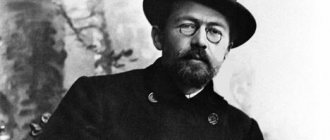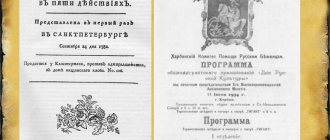History of writing
The novella was written in March 1916, when Bunin was on the Vasilyevsky estate in the Oryol province. It all started when the Moscow publishing house Russkoe Slovo asked him to send a short story for the Easter issue of their newspaper. Ivan Alekseevich did not mind sharing his short stories, since he valued friendly relations and generous fees, but the writer did not have any finished works. As a result, he decided to quickly put on paper the love story that had been languishing in his mind for a long time about the high school student Olya.
The very idea of the work came to Bunin much earlier. One day he was walking through the cemetery in Carpi, where he unexpectedly came across the grave of an unfamiliar girl. The photograph of a blooming, cheerful person created a sharp contrast with the oppressive atmosphere of this place, which shocked the writer to the core. His imagination immediately painted a picture of this girl’s life - and so the plan to create a work called “Easy Breathing” was born in his head.
According to Bunin himself, there were deeper preconditions for writing the novella. In deep childhood, he witnessed the death of his sister Sasha, whom the whole family loved very much. Childhood trauma deeply shocked the boy, forever leaving in his head images of winter, cloudy snow, an innocent girl and death, which were reflected in the future work of art.
Summary
The story begins with a description of the cemetery where the grave of the schoolgirl is located. The narration immediately stops at describing the heroine’s appearance - lively eyes, a joyful smile. From the first lines, the reader immediately understands that the story is about a cheerful, cheerful, optimistic girl . Then the story moves on to Olya’s childhood and adolescence - until the age of 14 she was an ordinary student, but then she “blossomed”, becoming one of the most popular schoolgirls among boys and classmates.
At the beginning of the story, Meshcherskaya appears as a very prosperous and happy person - she dances the best at the ball, is an excellent ice skater, and has many friends and boyfriends. In the last winter of her life, she practically “goes crazy with fun,” for which the head of the gymnasium calls her for a conversation. During the conversation, the girl admits that she is “already a woman” thanks to Malyutin.
After a frank conversation, there follows a scene at the station, where a Cossack officer shoots Olya. In court, he argues that she herself brought him to this point, vowing to be his wife and breaking her promise, and also offering to read the diary where she seduced another man. Then follows the story of her “fall” with Malyutin. At the end, the action moves again to the cemetery, where a classy lady visits Meshcherskaya’s grave.
Other characters
Cossack officer
- shot Olya because of unhappy love, “ugly and plebeian in appearance.”
Cool lady Olya Meshcherskaya
“In the cemetery, over a fresh clay mound, there is a new oak cross.” A convex porcelain medallion with a photographic portrait of schoolgirl Olya Meshcherskaya “with joyful, amazingly lively eyes” is embedded in the cross.
As a girl, Olya did not stand out among other schoolchildren; she was “capable, but playful and very careless about the instructions” of the class lady. But then the girl began to develop, to “bloom.” At the age of 14, “with a thin waist and slender legs, her breasts and curves were already well defined.” “At fifteen she was already considered a beauty.” Unlike her prim girlfriends, Olya “wasn’t afraid—no ink stains on her fingers, no flushed face, no disheveled hair.” Without any effort, “grace, elegance, dexterity, and the clear sparkle of her eyes” came to her.
Olya danced the best at balls, skated, was the most looked after at balls, and was loved most by the junior classes. “Unnoticedly she became a girl,” and there were even rumors about her frivolity.
“Olya Meshcherskaya went completely crazy with fun during her last winter, as they said in the gymnasium.” One day, during a big break, the boss called the girl over and reprimanded her. The woman noted that Olya is no longer a girl, but not yet a woman, so she should not wear a “woman’s hairstyle,” expensive combs and shoes. “Without losing simplicity and calmness,” Meshcherskaya replied that the madame was mistaken: she was already a woman, and the father’s friend and neighbor, the boss’s brother Alexei Mikhailovich Malyutin, was to blame for this - “this happened last summer in the village.”
“And a month after this conversation,” a Cossack officer shot Olya “on the station platform, among a large crowd of people.” And Olya’s confession, which stunned the boss, was confirmed. “The officer told the judicial investigator that Meshcherskaya lured him, was close to him, vowed to be his wife,” and at the station she said that she did not love him and “gave him to read that page of the diary that talked about Malyutin.”
“On the tenth of July last year,” Olya wrote in her diary: “Everyone left for the city, I was left alone. Alexey Mikhailovich arrived. He stayed because it was raining. He regretted that he didn’t find dad, he was very animated and behaved like a gentleman with me, he joked a lot that he had been in love with me for a long time. He is fifty-six years old, but he is still very handsome and always well dressed. Over tea we sat on the glass veranda, he smoked, then moved to me, began again to say some pleasantries, then examined and kissed my hand. I covered my face with a silk scarf, and he kissed me on the lips through the scarf several times... I don’t understand how this could happen, I’m crazy, I never thought I was like this! Now I have only one way out... I feel such disgust for him that I can’t get over it!..”
Every Sunday, after mass, a little woman in mourning comes to the grave of Olya Meshcherskaya - a cool lady girl. Olya became the subject of “her persistent thoughts and feelings.” Sitting at the grave, the woman remembers the pale face of the girl in the coffin and a conversation she accidentally overheard: Meshcherskaya told her friend about what she read in her father’s book, that supposedly the main thing in a woman is “light breathing” and that she, Olya, has it.
“Now this light breath has dispersed again into the world, into this cloudy sky, into this cold spring wind.”
Theme of the novella
The central theme of the work of art is love. It is revealed to the reader through the prism of the actions and behavior of the characters - first of all, the main character Olya Meshcherskaya. It is interesting that the role of love in the story departs from the classical canons - it acts as a destructive, destructive, uncontrollable force, and not a kind, pure and bright feeling. Olya's feminine attractiveness almost drives the young high school student Shenshin to suicide, and she herself dies at the hands of her rejected lover.
Side by side with love, the work reveals the theme of the value and beauty of life. Through the image of Meshcherskaya, Bunin is trying to show that you need to enjoy the world today, look at everything more simply and not limit yourself to rules. But it is important not to overdo it, taking the path of immorality and irresponsibility, otherwise you can share the sad fate of Olya, whose spontaneity and openness led to her death.
An important step in revealing this theme is the introduction of the image of a classy lady and contrasting her with the main character. This “elderly girl” and “ideological worker” is constrained by rules and traditions, but deep down she dreams of learning to live as easily and directly as Olya. This becomes her unattainable ideal and object of obsession. The contrast between her dreams and reality in “Easy Breathing”, the contrast of a joyless existence with Meshcherskaya’s short but bright and full of pleasures life best reveals the theme of the transience of existence and the importance of enjoying today.
Main issues
“Easy Breathing” reveals the writer’s views on many modern problems. The main ones:
- Balance between passion and decency. The author clearly sympathizes with Olya, who chooses the first and turns a blind eye to the second. But such a choice leads her to a sad outcome, which reflects the real state of affairs.
- Human freedom. Bunin portrays moral restrictions and obsession with traditions in a negative light, contrasting them with the open and spontaneous Meshcherskaya, who does not care about her reputation. He believes that society should not invade a person’s intimate sphere.
- Social inequality. Olya's conflict with both of her lovers stems from the fact that they are “from different classes,” and this leads to great tragedies.
- Boredom and dullness of life. The desire to break out of the routine of life and live in your dreams is the main characteristic of the cool lady character. Olya manages to do it by “breathing lightly,” but with dire consequences.
The author briefly dwells on the problem of the importance of family. Some quotes from Meshcherskaya hint at problems with her parents, and her upbringing speaks of abandonment and inability to live in the cruel outside world. None of the elders taught the heroine responsibility and standards of decency.
Image of Olya Meshcherskaya
The most developed and revealed in the short story is the image of the main character - high school student Olya Meshcherskaya. She embodies Bunin's ideal of feminine charm. Character traits inherent in her:
- ease;
- immediacy;
- openness;
- optimism;
- the desire to live for today and look for joy in everything;
- frankness;
- charm;
- femininity;
- irresponsibility;
- inability to take the feelings of others seriously;
- carelessness;
- frivolity;
- frivolity.
The author pays great attention to the appearance of the heroine. She is very beautiful, slender and graceful, which is why she has many suitors at a young age. corresponds to such lightness and grace - she is not constrained by any rules, she does what she wants , without thinking about the opinions of others. Despite the ambiguity and some immorality of her actions, it is almost impossible to condemn her because of her naivety and openness.
Olya's fatal flaw is her inability to find a balance between feelings and reason, freedom and constraint, reality and dreams. She is too frank and does not hesitate to tell the cruel truth, for which she ultimately pays with her life. The tragedy of the heroine lies in the fact that her defining character traits - spontaneity, love of life, faith in her dreams - ultimately lead to her death. She acts according to the will of feelings, not reason, for which she pays at the end of the story.
Relationship with the officer
In the plot of the story, the already mentioned officer kills Olya Meshcherskaya, involuntarily misled by her game. He did this because he was close to her, believed that she loved him, and could not survive the destruction of this illusion. Not every person can arouse such strong passion in another. This speaks to Olya’s bright personality, says Bunin (“Easy Breathing”). The act of the main character was cruel, but she, as you might guess, having a special character, stupefied the officer unintentionally. Olya Meshcherskaya was looking for a dream in her relationship with him, but she failed to find it.
Characteristics of other heroes
“Easy Breathing” is a short novella that cannot boast of a rich cast of characters . Most of them are to some extent opposed to the image of Meshcherskaya:
- Alexey Mikhailovich Malyutin is a 56-year-old officer, a family friend of the Meshcherskys, a handsome elderly man. One day he is left alone with a girl at home, does not hold back and seduces her. Despite the initial desire to “become a woman,” Olya feels disgust for him, which she openly admits. Later, Malyutin dies in the Russian-Japanese War, in the same winter as the main character.
- The Cossack officer is Olya's lover, a mysterious and dark character, about whose motives little is known. He is described as an ugly and poor man. The nuances of his relationship with the main character remain behind the scenes, but it is clear that he took the romance very seriously - so much so that he took the life of his beloved after learning about the non-reciprocity of his feelings. For Meshcherskaya herself, their relationship was something of an experiment or a passing hobby, while the officer wanted a wedding, which became the cause of the conflict and the subsequent death of the girl.
- The headmistress of the gymnasium is a strict, correct woman who condemns Olya’s flighty behavior. Shackled by her own moral teachings and attitudes, she turns out to be completely disarmed by Meshcherskaya’s spontaneity and frankness, despite her position of power in relation to the schoolgirl. The conversation with her, despite its short duration, is often called one of the most memorable moments of the story.
- A cool lady is a middle-aged woman who lives in dreams instead of reality. For her, Olya becomes something of an ideal, and she considers her cruel fate to be the embodiment of the injustice of the world. After Meshcherskaya’s death, a classy lady regularly visits her grave, indulging in sentimental reflections.
The uniqueness of each character in the story lies in the ambiguity of his motives. The psychology and deep thoughts of the characters are left behind the scenes, which allows the reader to understand them in their own way.
Features of the composition
The main feature of the story's composition is the lack of chronological sequence. The text begins with a description of Olya's grave, then jumps to a description of her childhood, then moves on to her last winter. After all this, a conversation with the boss follows, where some of the key details of the plot are revealed, including the heroine’s connection with Malyutin. Then the work returns to the news of the death of the schoolgirl. The end is an insignificant at first glance episode from Meshcherskaya’s daily life, where she tells her schoolgirl friends about the meaning of female beauty.
Thanks to the sudden change in place and time of action, the author managed to maintain a feeling of lightness. Despite the unfair blows of fate and multiple dubious or tragic events, the short story does not burden the reader with heavy thoughts - he becomes detached, distanced from the heroes and their problems.
Another feature of the composition is the swiftness of everything that happens, which emphasizes the lively and spontaneous nature of the main character. Events happen so quickly that the reader has practically no time left to analyze the essay - he, like Meshcherskaya, perceives it with his feelings, and not with a cold mind. This corresponds to the picture of Olya’s life - she always “lived in the moment”, without thinking about the long-term consequences of her actions.
Another interesting detail is that the author actually begins his work with a denouement, depriving it of an unexpected twist in the form of the death of the heroine. The reader knows that a sad outcome is inevitable, so he better concentrates on the reasons and events leading to the tragic ending. Olya’s predetermined doom, the unimportance of her actions and decisions help convey the idea and meaning of “Easy Breathing” - it was the desire to live to the fullest, have fun and not pay attention to the consequences that led the girl to a sad outcome.
First impression
At first glance, the events seem messy. The girl plays at love with an ugly officer, far from the circle to which the heroine belonged. In the story, the author uses the so-called “proof by return” technique, since even with such vulgar external events, love remains something untouched and bright, does not touch everyday dirt. Arriving at Olya’s grave, the class teacher asks herself how to combine all this with a pure look at “that terrible thing” that is now associated with the name of the schoolgirl. This question does not require an answer, which is present in the entire text of the work. It permeates Bunin’s story “Easy Breathing” through and through.
Reader reviews
The work evokes a storm of emotions, despite its short length. The female characters are so well written that they simply come to life before your eyes. Reading helped me better understand myself and those around me.
Lida
The novella tells about a girl who got into too much trouble for her age and intelligence. But despite the fact that the heroine is still “well done,” you sincerely empathize with her. The text perfectly balances between lightness and darkness.
Alexei
A beautiful and sad story that touches on the themes of the transience of life, the destructiveness of passion and the danger of female attraction.
The image of the heroine gives you goosebumps, especially when you compare her with some acquaintances from real life. Yaroslav
Genre
When analyzing the genre of the work “Easy Breathing”, it should be noted that it was written in the genre of a short story - a short plot story, which fully reflects the problems and ideas that concern the author, and presents a picture of the life of heroes from various groups of society.
Being a supporter of realism, Ivan Alekseevich could not stay away from modernism, which was increasingly gaining momentum in the twentieth century. The brevity of the plot, the symbolization and ambiguity of details, the fragmentation of the story described and the demonstration of unembellished reality indicate that the short story “Easy Breathing” is closer to modernism, but it also contains the main tendencies of realism.







